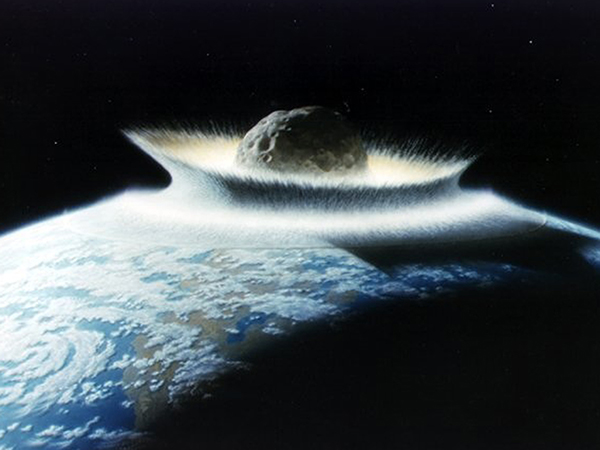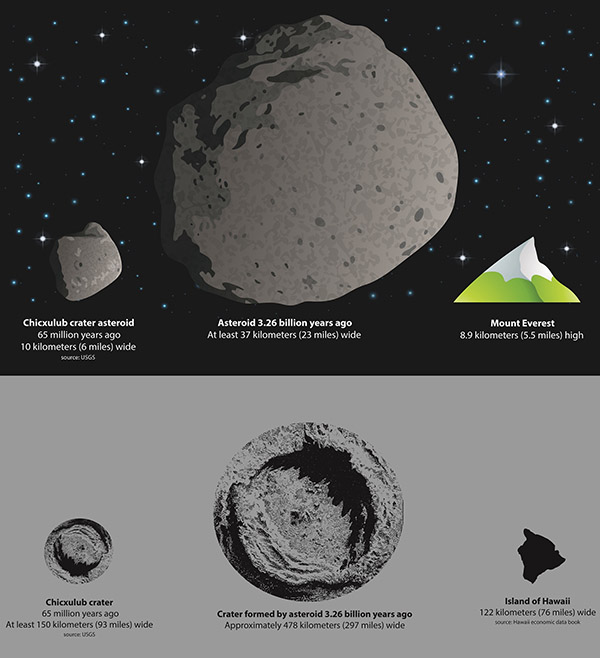
by Jesse Davenport Tuesday, August 12, 2014

An artist's rendering of an asteroid impacting Earth. Credit: NASA/Don Davis.
The crater left by the infamous Chicxulub asteroid responsible for finishing off the dinosaurs about 65 million years ago, was more than 19 kilometers deep and 177 kilometers in diameter. Those dimensions correspond to a huge energy release estimated at 100 teratons of TNT, but that’s puny compared to an impact that struck South Africa’s Barberton Greenstone Belt about 3.26 billion years ago. Now, researchers have estimated just how big that massive asteroid was and the catastrophic effect it might have had on Earth and its budding plate tectonic system.
Large cratering events “tend to be very old, more than 2 billion years, and are very heavily eroded,” says Ross Potter, a research scientist at the Lunar and Planetary Institute (LPI) in Houston, Texas, who was not part of the new study. Age and erosion “can make it very difficult to identify a crater, especially if it was originally greater than 100 kilometers in diameter, such as Vredefort [in South Africa] and Sudbury [in Canada],” he says.

An illustration showing the relative sizes of the Chicxulub impact and the Barberton impact, with Mount Everest and the Big Island of Hawaii for scale. Credit: AGU.
However, slight but significant evidence for the Barberton Greenstone Belt event was discovered more than a decade ago by geologists studying areas in South Africa and Western Australia, which were connected at that time of the impact. The belt is located along the edge of the Kaapvaal Craton and is home to an unusual type of volcanic rock called komatiite, which comprises some of the oldest exposed rock on Earth. The region also hosts diamonds as well as some of the earliest traces of life. A more subtle feature of the greenstones are layers of spherules, small particles that condensed from all of the rock vapor and debris in the atmosphere immediately after the impact. When analyzed, geologists found elevated concentrations of iridium and unusual chromium isotopes, key indicators of impact events. Scientists also found shatter cones, Potter says, as well as shocked quartz grains and “other high-pressure mineral phases such as stishovite” — further telltale signs of an impact. These geologic observations have been synthesized from numerous publications and field studies in South Africa over the past two decades.
The new study — published in the journal Geochemistry, Geophysics, Geosystems by geophysicist Norman Sleep and sedimentologist Donald Lowe, both of Stanford University — relied on the established geology of the site and on detailed modelling. The work revealed the size of the impactor — estimated at 37 kilometers diameter to be five times larger than the one that hit Chicxulub — and the resulting crater, which they suggested was more than 480 kilometers in diameter.
Sleep and Lowe suspect that the effects of the impact in South Africa would have been immediately evident. The skies would have been heated tremendously and filled with dust, debris and rock vapor, much of which would have circled the globe before solidifying and falling back to Earth. According to their model, the impact would have triggered a gigantic magnitude-10.8 earthquake, setting off a chain reaction of other large earthquakes and tsunamis around the planet.
The researchers used a combination of geophysical parameters — such as differing sizes, densities and velocities of the ambient body — the iSALE hydrocode model, and the geological characteristics of the Barberton Greenstone Belt and other impacts on Earth and the moon as a guide to calculate the scale and effects of such an event. Using these impact characteristics, they then modeled how seismic waves traveled from the impact site to the Barberton Greenstone Belt — thousands of kilometers away — as well as how the waves affected the rocks of the formation. Hydrocode modeling provides a powerful tool for studying cratering process at large scales, “especially when the models are constrained by geological observations,” Potter says. Although for events like Barberton, he says, such modeling can still be difficult, because the physical evidence of the crater is fairly scant.
Not much is known about what life was like more than 3 billion years ago in the Archean, but studies like this are trying to get at what might have been happening. Large asteroid impacts such as the South African event could have had major influences on the fledgling plate tectonic system and emerging life, Potter says, but the extent of this influence is far from clear. “Personally, I am not convinced by an impact like this jump-starting plate tectonics,” he says. “The impact is likely to have created earthquakes, but anything more substantial than that, such as plate tectonics, seems conjecture.”
© 2008-2021. All rights reserved. Any copying, redistribution or retransmission of any of the contents of this service without the expressed written permission of the American Geosciences Institute is expressly prohibited. Click here for all copyright requests.